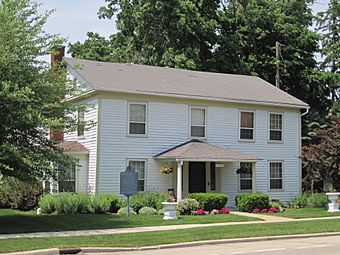Plainfield Halfway House facts for kids
Quick facts for kids |
|
|
Plainfield Halfway House
|
|

Plainfield Halfway House in 2011
|
|
| Location | 503 Main Street Plainfield, Will County, Illinois, United States |
|---|---|
| NRHP reference No. | 80001421 |
| Added to NRHP | September 29, 1980 |
The Plainfield Halfway House is a very old and important building in Plainfield, Illinois. It was added to the National Register of Historic Places in 1980 because of its special history. This building got its name because it was a popular stop for travelers.
Contents
The Plainfield Halfway House: A Historic Stop
The town of Plainfield was first settled in the 1820s. Early settlers came to the area, including a group who wanted to teach the local Potawatomi people about Christianity.
Early Days as an Inn
A man named Squire L. F. Arnold owned the land where the Halfway House stands today. He was the first postmaster in Plainfield, meaning he was in charge of the local mail. In 1834, he built a small building. This building served as both a post office and a place where stagecoaches could stop. Stagecoaches were like old-fashioned buses pulled by horses, used for travel before cars and trains.
In 1836, the property was sold. A new, two-story building was built right next to the first one. This new building became a tavern and an inn. An inn was a place where travelers could eat, drink, and sleep. It was called the "Halfway House" because it was exactly halfway along the stagecoach route between Chicago and Ottawa.
A year later, in 1837, Dr. Erastus Wight started managing the inn. He ran it until he passed away in 1845. His son, Dr. Roderick Wight, took over the business. In 1850, Roderick bought the building. He also added a one-story section to the back of the inn that same year.
A Busy Meeting Place
Because the inn was quite large, it became a central spot for the town. In its early years, it was used as a meeting hall for town business. It also became the main place for social events in Plainfield. People would gather there for parties, dances, and other community activities.
From 1856 until the Civil War began, a local military group called the Plainfield Light Artillery used the building as their headquarters. This means it was their main office and meeting spot.
From Inn to Home
The building stopped being an inn in 1886. After that, it was changed into a private home. The Wight family, who had owned and managed the inn for many years, continued to live there until 1956.
The very first building that Squire Arnold built, which served as the post office and stagecoach stop, was torn down in the 1940s. However, the larger two-story inn building still stands today. It was officially recognized as a historic place when it was added to the National Register of Historic Places on September 29, 1980.



